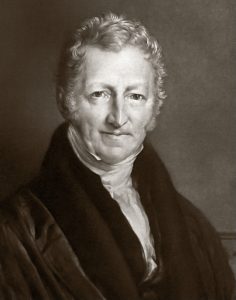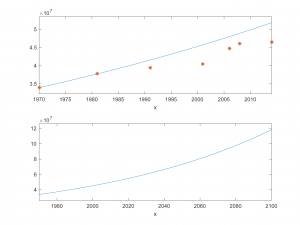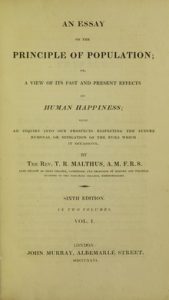1.- Introduction of the Malthusian model
Thomas  Robert Malthus was born in 1766 in Surrey, a county in south-east England, UK. He attended Jesus College, Cambridge, where he studied philosophy and theology until he graduated as an Anglican minister in 1788. From that year he remained at Cambridge as a fellow until 1804, when he married and had to resign his office, according to the rules of Jesus College.
Robert Malthus was born in 1766 in Surrey, a county in south-east England, UK. He attended Jesus College, Cambridge, where he studied philosophy and theology until he graduated as an Anglican minister in 1788. From that year he remained at Cambridge as a fellow until 1804, when he married and had to resign his office, according to the rules of Jesus College.
In 1798, at the age of 32, Malthus published anonymously a book entitled An Essay on the Principle of Population, of which up to six editions were published, in which the author added new data in an attempt to justify and support his postulates. Since its publication, this book has had a great impact on economic sciences, but we will focus our attention on its importance in population dynamics, i. e. demography.
Malthus wanted to explain the reason for the poverty that existed in those times, and he formulated a theory that can be summarised briefly in the following statement: “When no obstacle prevents it, population doubles every 25 years, growing from period to period, in a geometrical progression. The means of subsistence, in the most favourable circumstances, increase only in an arithmetical progression”. His view was that improvements in agricultural technology and food production would only bring temporary improvements as they would be consumed by the excessive increase in population.
2.- Malthusian catastrophe
Under this assumption, Malthus foresaw a Catastrophe in the year 1880, because if population grows geometrically and resources arithmetically, there would be a time when people would have no resources to survive, they would live in misery. To avoid such a catastrophe, several controls can be proposed to prevent exaggerated population growth. Some can be intrinsic (diseases, wars, epidemics, bad food, hunger…) and others that Malthus himself strongly suggested (of very different types) in population growth. He proposed, for example, birth controls and reducing or eliminating the poor. Malthus’s proposals had such an impact that even the English government enacted laws against destitution.
The Malthusian catastrophe did not occur because, on the one hand, Malthus did not take into account the great capacity that man has had to generate food, technology also grows, and therefore, methods to develop more food grow. On the other hand, many societies moderated their birth rate as they reached a higher level of income.
3.- Can the Malthusian model be a good approximation?
Despite the failure of Malthusian predictions, this model has continued to be used to model the behaviour of some species (for example, to model the initial growth of bacteria on a nutrient-rich substrate, where bacteria can grow and reproduce without restriction). The law can be written in terms of differential equations as follows: the growth of a species is proportional to the number of individuals of the species; or, that the growth rate of the species is constant. This assumption makes the population grow exponentially, as predicted by Malthus, albeit with a constant speed that is in principle unknown. On the other hand, food growth, as Malthus himself proposed, was constant, so food grew linearly.
It is clear that Malthusian model is too simple and unrealistic to capture the complex behaviour of a population. In reality, according to this model, either a population will grow uncontrollably over time or the species will decline until it disappears.
Obviously, one of its major limitations is that it assumes that the growth rate of the species remains constant over time, is always the same and does not depend on other factors or resources, such as the species itself.
Here are some examples of how a given population would vary according to Malthus’ model. Let us take the Spanish population as an example. The following table shows the growth of the Spanish population since the beginning of the 20th century:
| 1900 | 1910 | 1920 | 1930 | 1940 | 1950 | 1960 |
| 18.616.630 | 19.990.669 | 21.388.551 | 23.677.095 | 26.014.278 | 28.117.873 | 30.582.936 |
| 1970 | 1981 | 1991 | 2001 | 2006 | 2008 | 2014 |
| 33.956.047 | 37.742.561 | 39.433.942 | 40.499.791 | 44.708.964 | 46.063.511 | 46.507.760 |
If we take as a reference the rate of growth of the Spanish population in the 1970s, this rate (calculated by adjusting the known data) is 0.009611040332240, so that according to Malthus’ law in 2014 we would have a population of 51,829,149 !!! for the 46,507,760 that there were according to the data, and an estimate of 118,451,334 inhabitants for 2100.
In the following upper chart we compare the real population in Spain since 1970 and 2014 (expressed with *) and the estimation with the Malthus model (continuous curve).  The lower one shows the profile of the solution up to the year 2100.
The lower one shows the profile of the solution up to the year 2100.
It may seem that we have chosen a period in which the so-called baby boom occurred in Spain and therefore the forecast was not correct. However, if we take the average velocity since 1900  up to 1980, 0.007695460854668, we get, according to the Malthus model, a population in 2014 of 44,761,025… and 86,760,152 inhabitants in 2100. In the following figure (right) we show again on the one hand (upper chart) the comparison of the real population with the estimate by the Malthus model from 1900 to 2014. The lower figure shows this estimate up to the year 2100.
up to 1980, 0.007695460854668, we get, according to the Malthus model, a population in 2014 of 44,761,025… and 86,760,152 inhabitants in 2100. In the following figure (right) we show again on the one hand (upper chart) the comparison of the real population with the estimate by the Malthus model from 1900 to 2014. The lower figure shows this estimate up to the year 2100.
That is, even with a growth rate calculated, on average, over one century, the model ceases to be realistic when a significant amount of time is left to pass.
On the other hand, taking as a datum that in 2013 Spain has a negative growth rate of -0.2%, the population in the next 50 years will follow, according to Malthus’ law, the following graph:

According to this estimate, if the negative growth rate continues over the years, in 2065 there will be approximately 42 million inhabitants in Spain.


La Inglaterra de esos tiempos se caracterizaba por atravesar una difícil época de hambre y pobreza, lo que Malthus pretendía era explicar la razón de esa pobreza formulando un teoría “cuando no le impide ningún obstáculo, la población va doblando cada 25 años, creciendo de periodo en periodo, en una progresión geométrica, y los medios de subsistencia mas favorables, no se aumentan sino en una progresión aritmética”. Es decir la población crece en forma geométrica y los recursos en formas aritmética, llegaría un momento donde las personas no tendrían recursos para sobrevivir, y vivirían de la pobreza, para evitar dicha catástrofe se puede proponer controles que eviten el crecimiento exagerado de la población. Unos pueden ser intrínsecos (enfermedades, guerras, epidemia, hambre,..) y también controlar los nacimientos es decir la finalidad de este modelo era reducir o o eliminar a los pobres. Tubo tanta repercusión los planteamientos de Malthus que Inglaterra promulgo leyes en contra de la indigencia.
Dicha catástrofe no se produjo ya que Malthus no tubo en cuenta la gran capacidad que tiene el hombre para generar alimentos, el crecimiento de la tecnología, los métodos para desarrollar mas alimentos, y también muchas sociedades moderaron su indice de natalidad.
A pesar del fracaso de dicho modelo para prevenir siguió usándose para modelar el comportamiento de algunas especies como por ejemplo el crecimiento y reproducción de algunas bacterias. Dicha ley se puede escribir en terminarnos de ecuaciones diferenciales.
Es decir el modelo de Malthus es muy simple y poco realista para ser aplicado en la población, según este modelo o la población crecía en forma incontrolada a lo largo del tiempo o decrecía hasta desaparecer, no tubo en cuenta otros factores o recursos como por ejemplo la misma especies
Solo hay que ver que la predicción de Malthus se está cumpliendo;sequías,deshielos,catástrofes, hambrunas, pandemias y guerras.